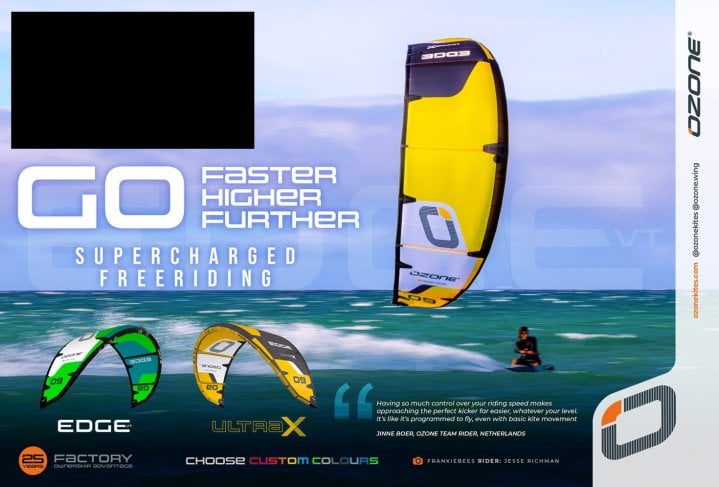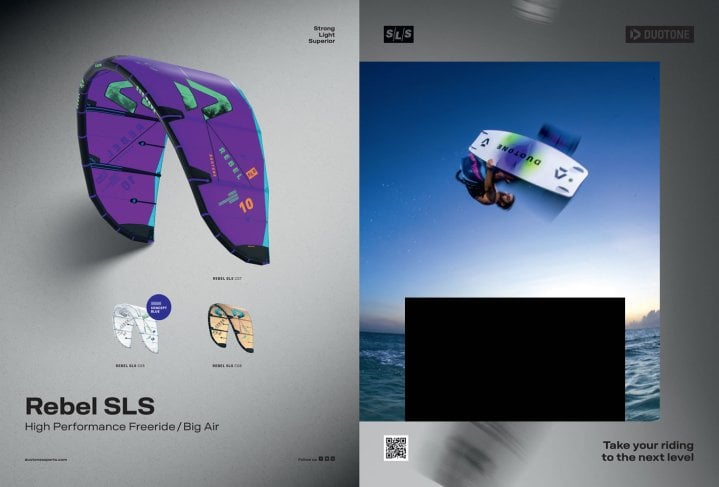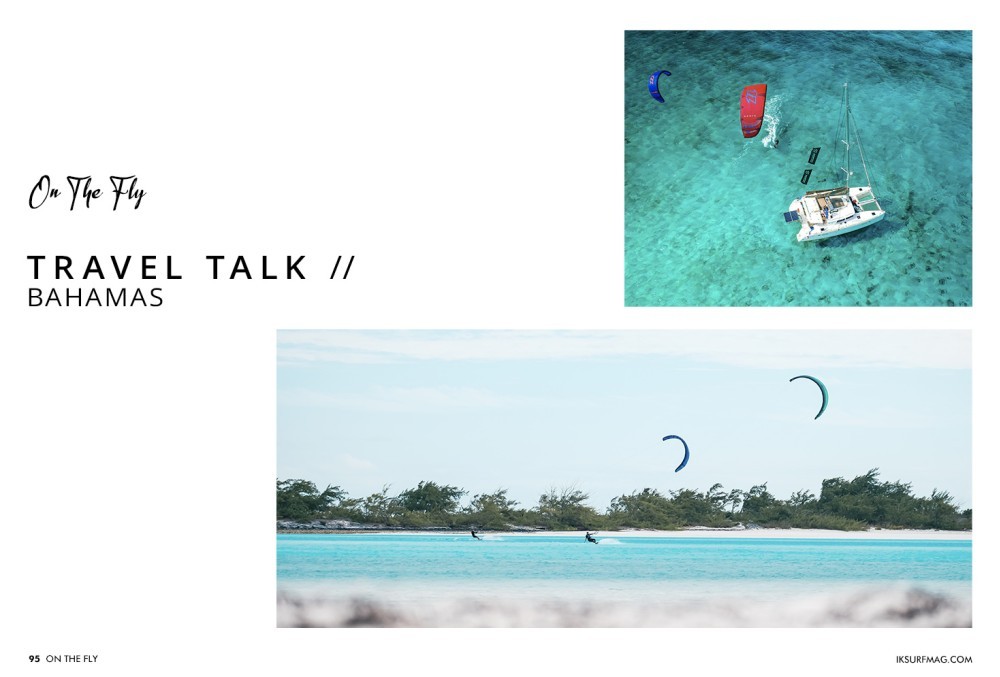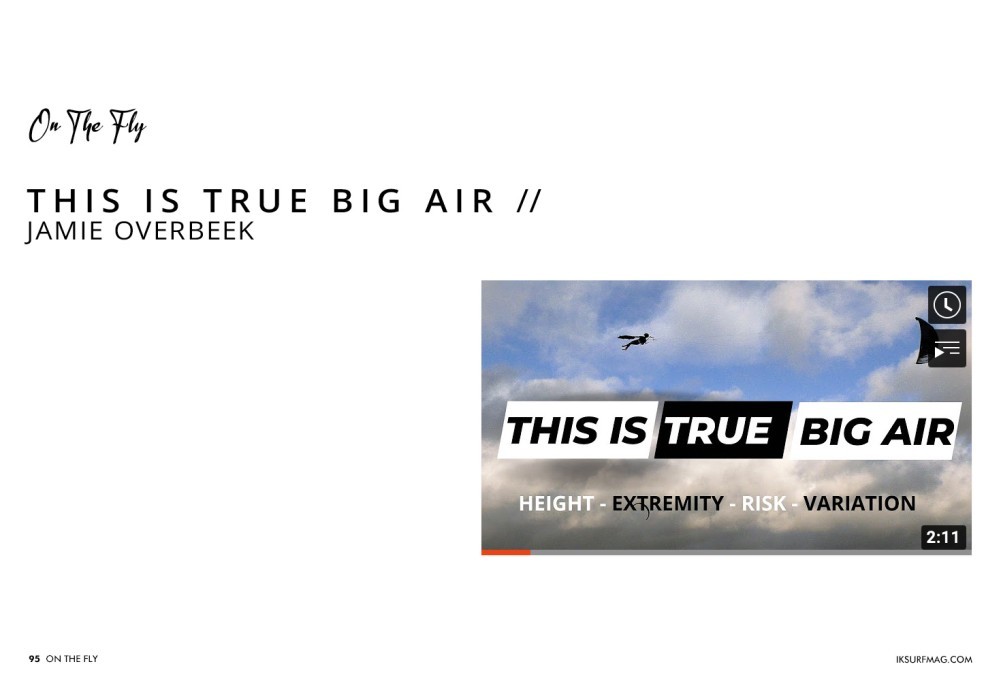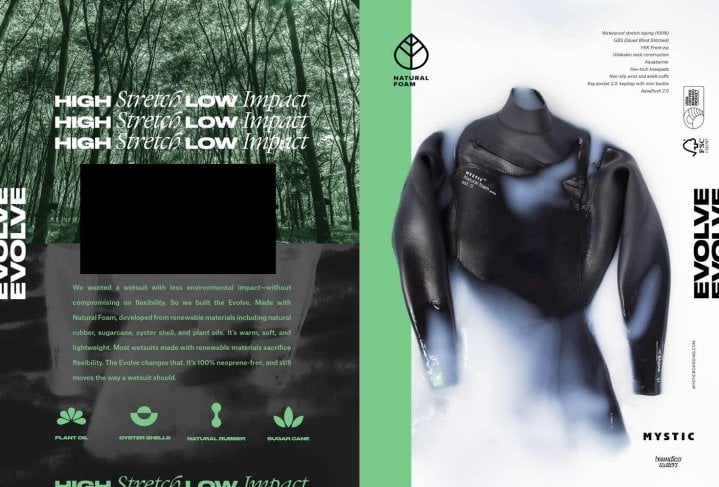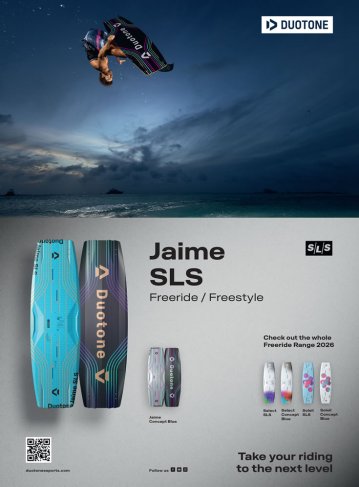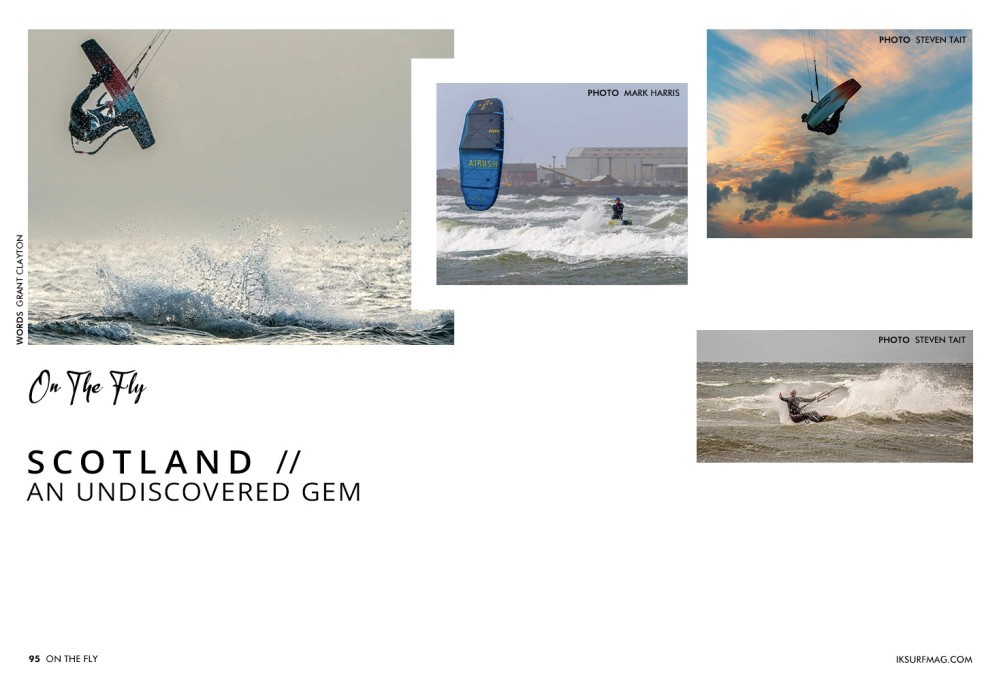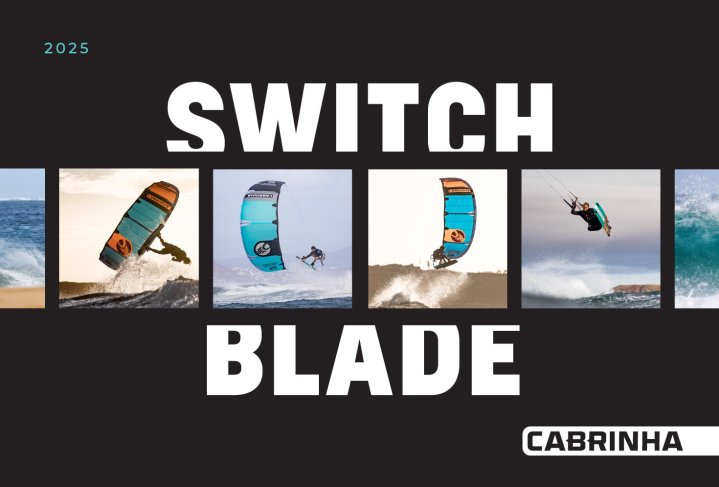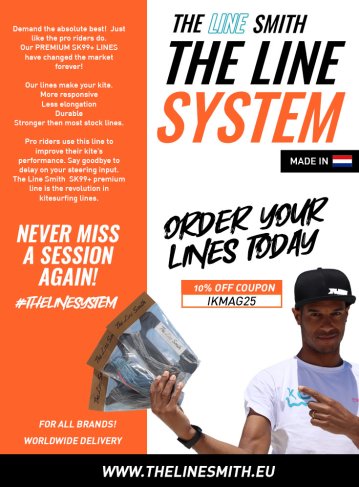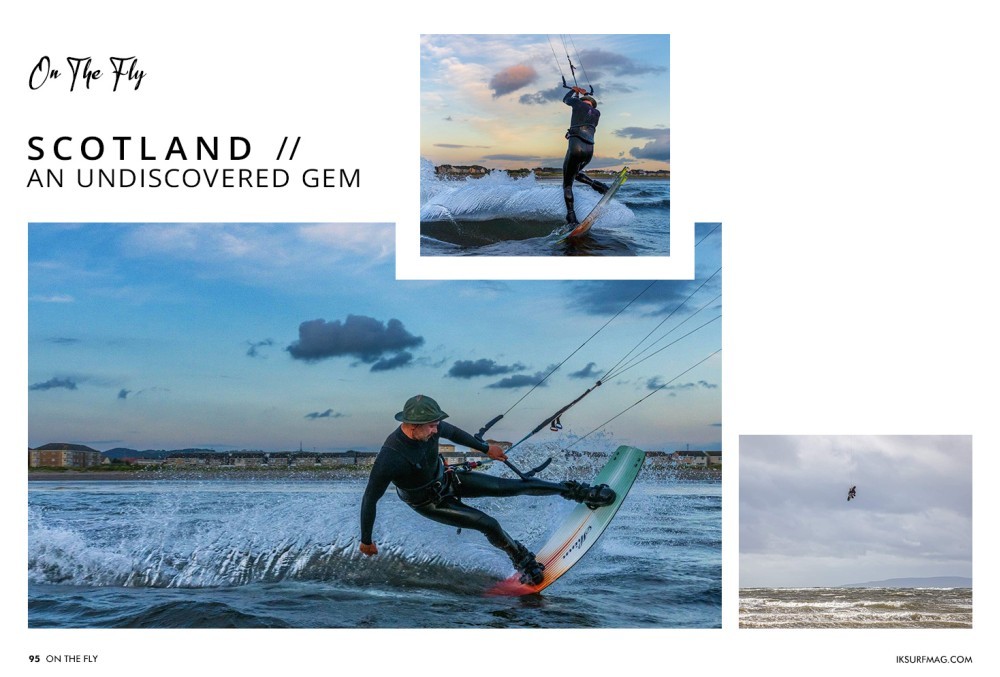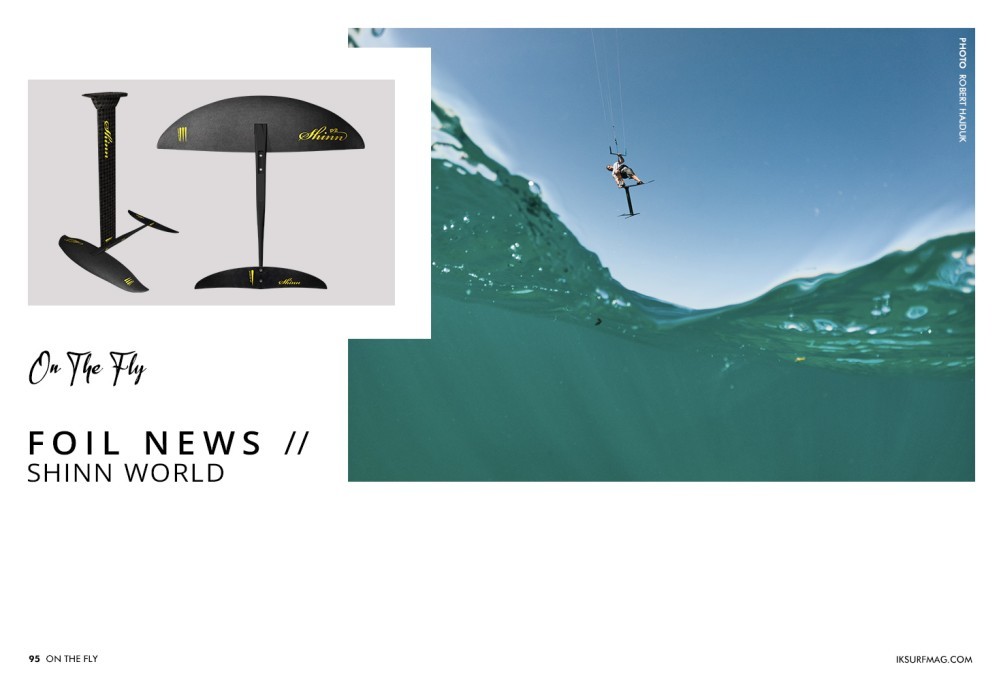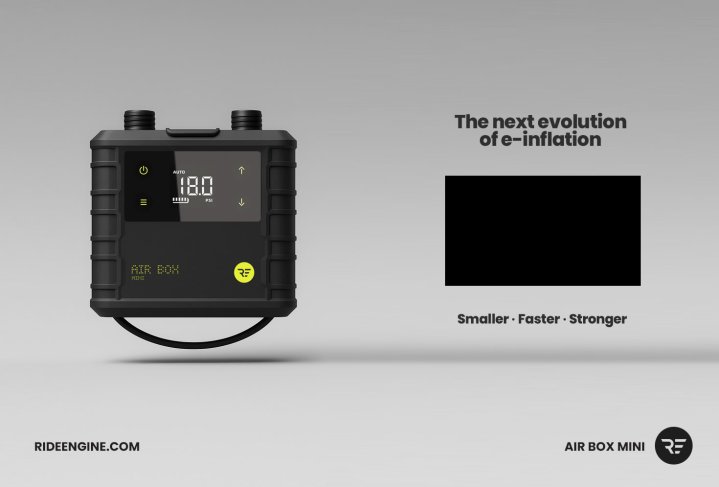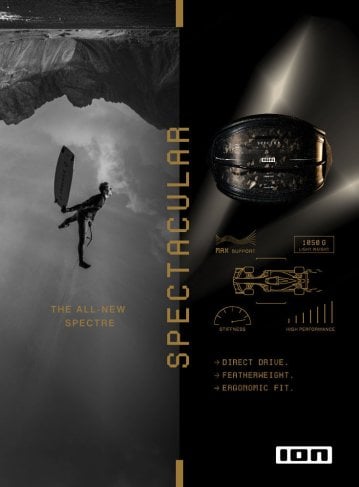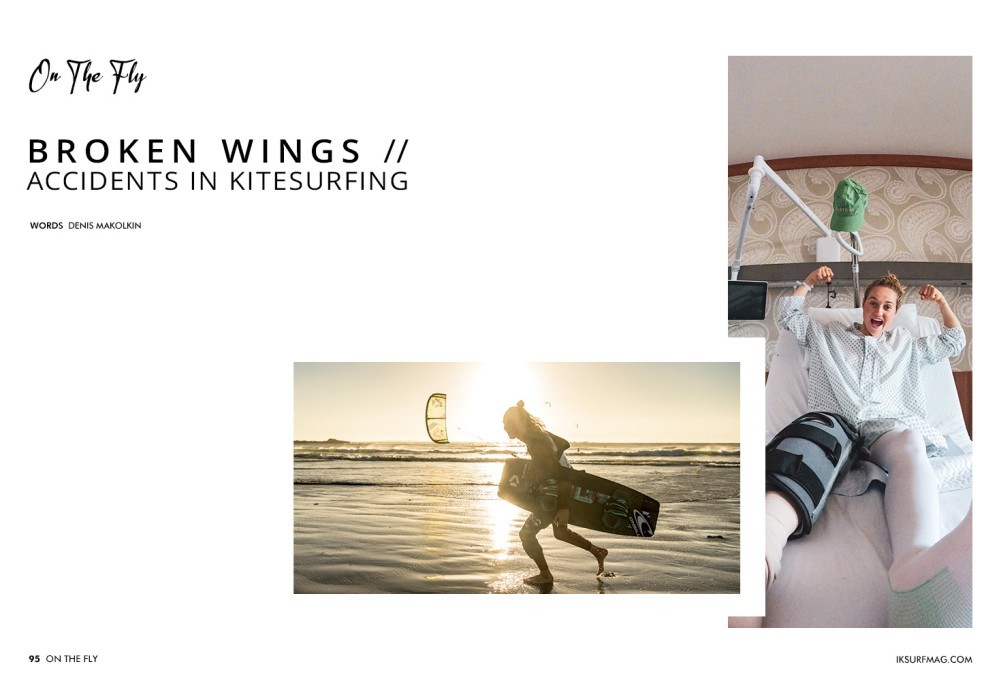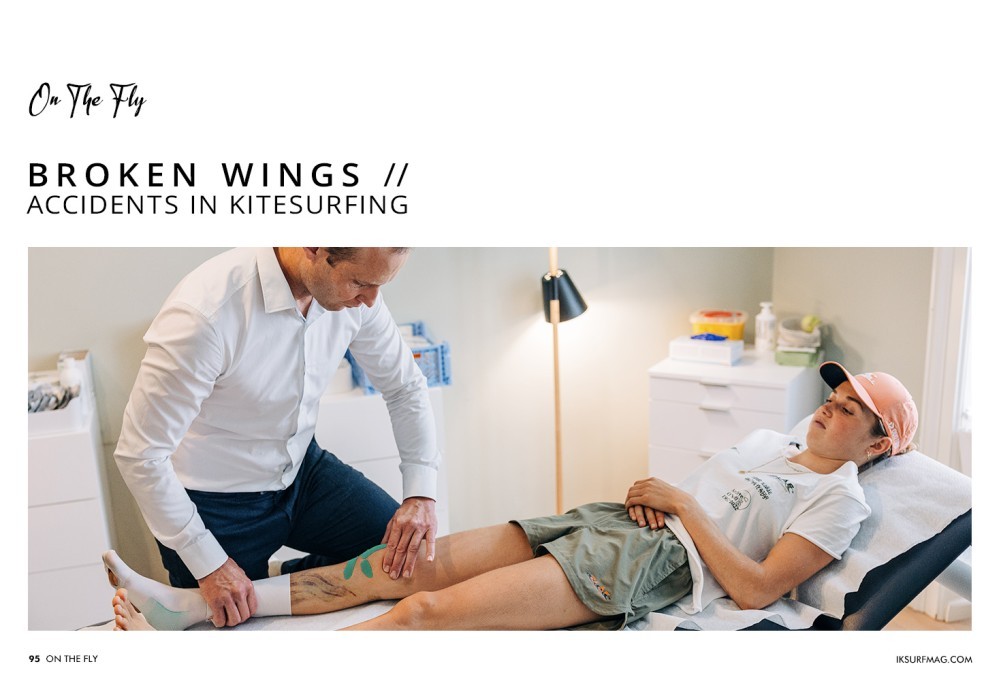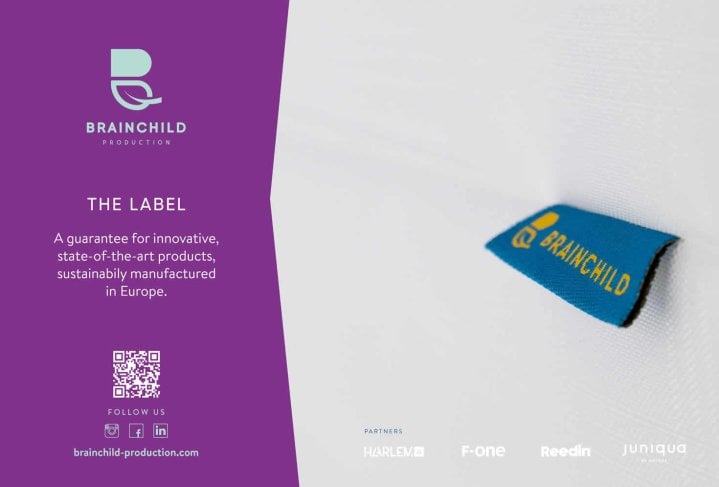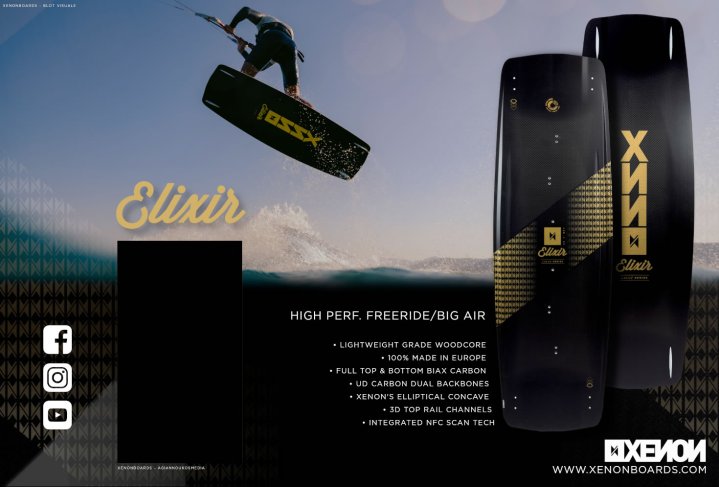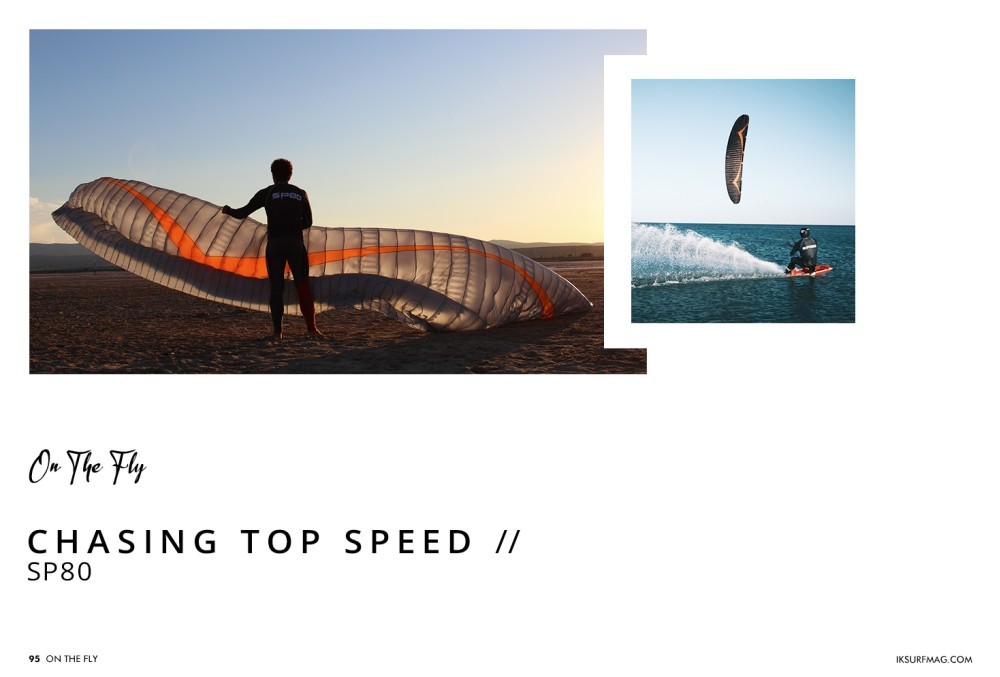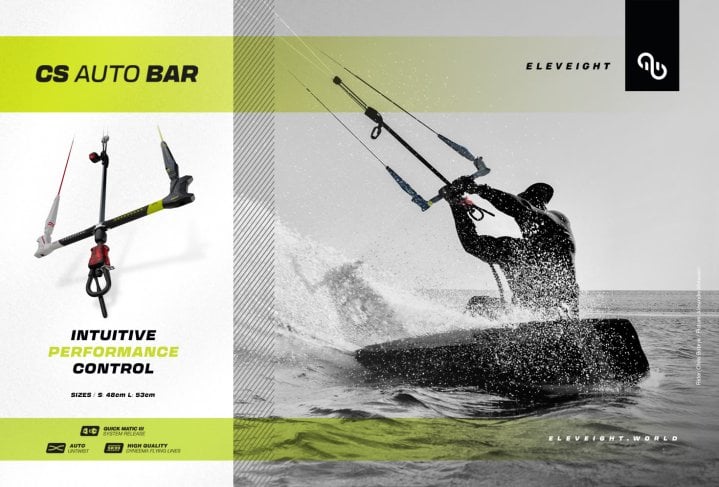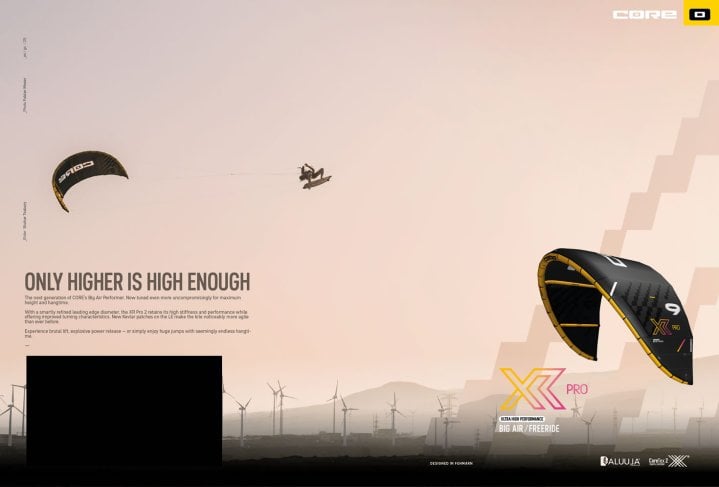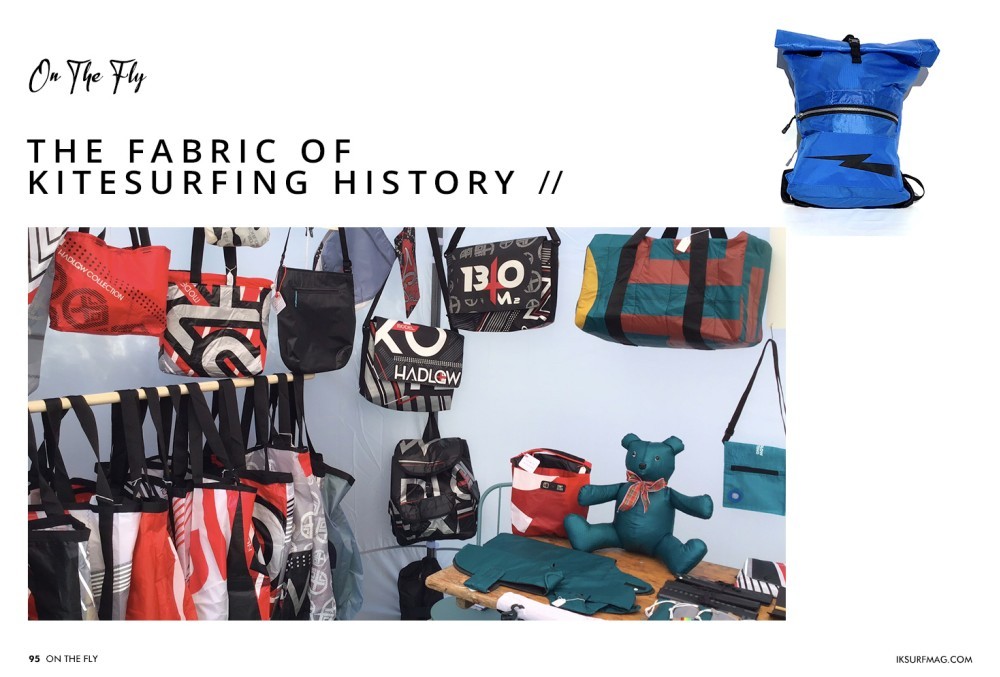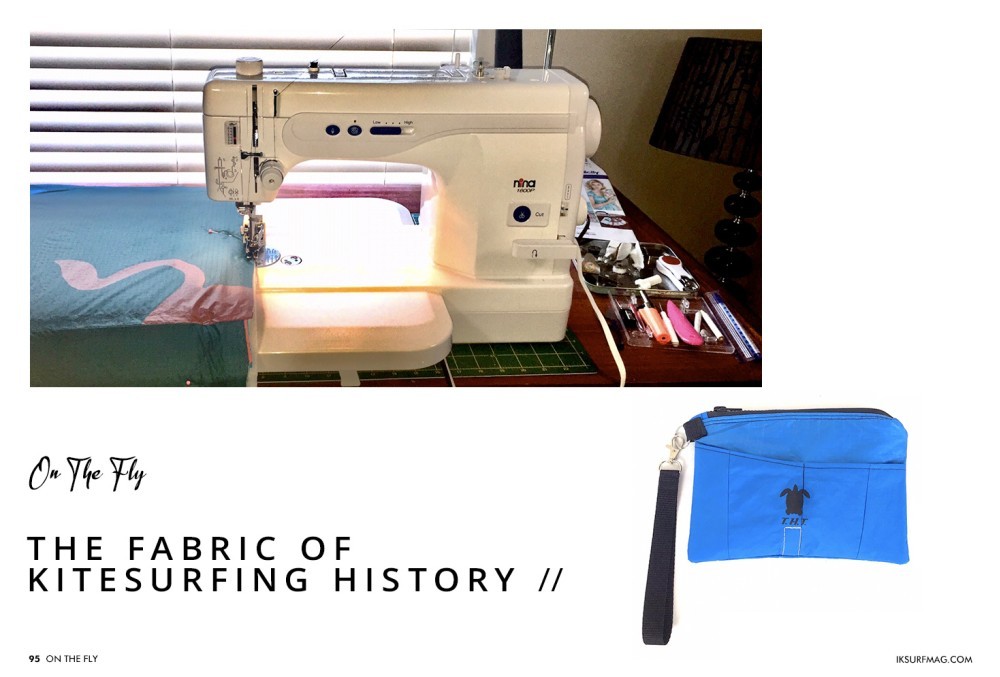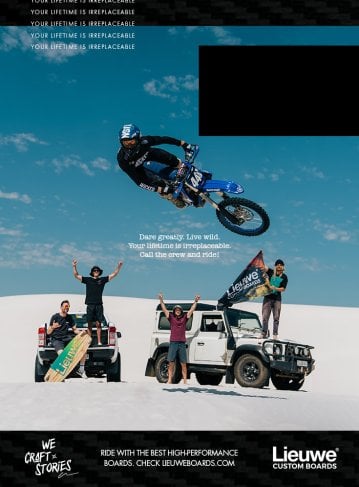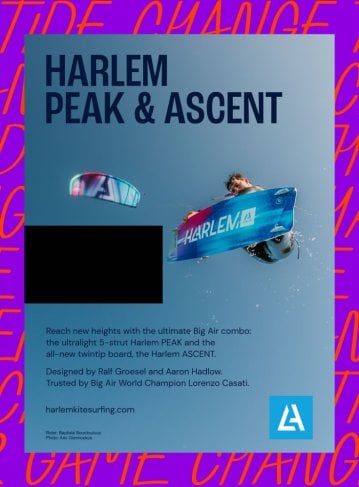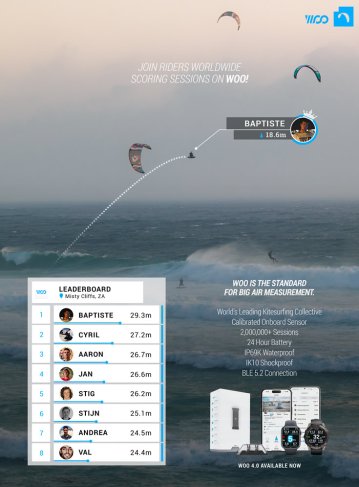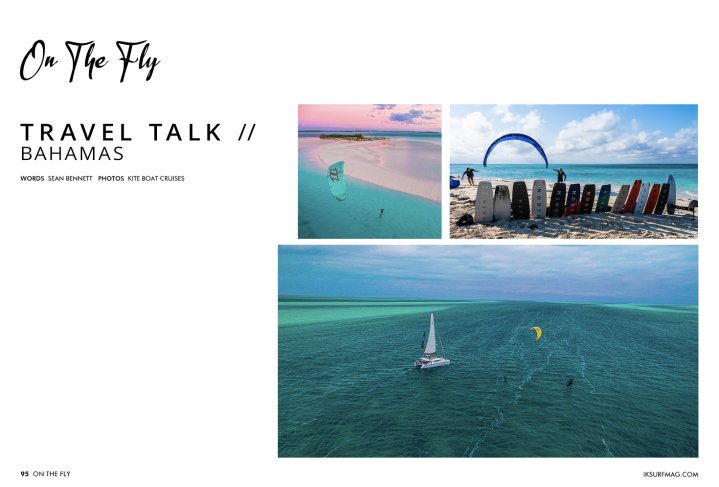
On The Fly
Issue 95 / Wed 5th Oct, 2022
Find out what’s happening in the world of wind in On The Fly! Check out features on the Bahamas and Scotland, talk big air with Jamie Overbeek, hear from Denis Makolkin on kiting injuries, and find out about the Fabric of Kitesurfing History with Louise Hadlow. There’s world records, new gear, and more, in On The Fly!
TRAVEL TALK // Bahamas
During a week of exploration in the beautiful Bahamas, Kite Boat Cruises took me to some of the most epic places I have ever kited. The wind was awesome, the islands were incredible, and the water was the most insane blue you have ever seen!
It was like a playground with no one else around; great wind, sunshine and the magical feeling that comes from travelling to these remote spots by sailboat. Every day, we would explore a new kite spot, each and every one with beautiful sandy beaches to launch from. The Bahamas has so many different spots with unique features like a new land gap or tree to kiteloop over. On the days without wind, we had the opportunity to go snorkelling and island hopping. We saw an abundance of marine life, swam through the James Bond cave, and swam with pigs!
Sailing made the experience even more memorable, and it was a lot of fun learning some things about sailing and watching the boat set sail to new spots. As kiteboarders, we are always in tune with the wind, and it’s so interesting to see how the wind knowledge from kiting transfers over to sailing. Sailing allows you to really connect with the ocean and the elements. Waking up in the morning and looking at the whitecaps is the best way to start your day!
Every day, after breakfast, Captain Aritz would take us on the dinghy to a new beautiful sandy beach for our kite session! Aritz and Ale, the instructor, always kept an eye on the kiters from the beach and were ready to help with the dinghy if needed.
On my birthday we loaded the dingy with a ton of gear and set up on a private island. This day we kited and foiled next to the catamaran while Aritz made tacks. FULL SAIL!! It was absolutely unreal to be out there in the crystal blue water kiteboarding alongside the Madrigal V. What an epic day!
While I thought I was going to be eating pasta and sandwiches, as is often the case on a kiteboarding trip, we ate like kings and queens. Chef Lauren did an absolutely amazing job preparing breakfast, lunch and dinner every day. We feasted on fresh poke bowls, tropical red snapper with coconut rice, and even delicious fillet mignon on my birthday! Of course, there were always tasty snacks in between kite sessions, snorkelling and exploring new spots!
I am constantly amazed by the beauty of the Bahamas, the professionalism of Kite Boat Cruises, the quality of the crew and boat, and the killer kitesurfing! The crew is extremely knowledgeable about sailing, kiteboarding and they always have a TON of the latest gear to ride! I can’t wait to go back!
Read more about kiteboarding trips in the Bahamas with Kite Boat Cruises in our Travel Guide at IKSURFMAG.com or at https://KiteBoatCruises.com
THIS IS TRUE BIG AIR // Jamie Overbeek
After a strong showing in the recent Cold Hawaii event, Jamie Overbeek was unfortunately knocked out of the event by rider Luca Ceruti. Viewers could see a major difference in their riding styles and approach to big air. We caught up with Jamie Overbeek to get his perspective!
Your action-packed edit, “This is True Big Air Kitesurfing”, was very impressive! To you, what defines Big Air?
Well, for me, it's defined by the word BIG in big air; that is the equivalent of extreme height in extreme conditions, 40+ knots at least. In these conditions, daring to perform technical kiteloop variations at 20+ metres with massive horizontal pull, including boardoffs and added rotations with low kite angles (kite horizontal with the rider or even lower) has the wow factor. That, to me, is the definition of big air.
There’s some big change in the big air world, which was apparent to anyone that tuned into the recent Cold Hawaii event. Jamie, what types of tricks were getting the top scores in the event?
During the event, it quickly became clear that the prevailing big air tricks that used to get the high scores were no longer the best. This event, the highest scoring tricks were the new double loops and s-loops.
What were the judging criteria that the readers had to work with at Cold Hawaii?
Judging criteria, on paper, were height, extremity, risk and variation, which has always been the case. But, what was notable is that the 70% for height wasn't mentioned anymore. So, that was a sign that things from a judging point of view could be changing compared to previous competitions. Still, it was made clear that lower jumps with high kite angles and very basic tricks wouldn't be rewarded with big scores. The judges made it clear they were looking for extremity, risk and innovation. On top of that, the variety score given at the end of the heat would count for 25% of the overall score.
There was a trend during the event of riders performing half of their heat on a bigger kite, getting some points on the board, and then swapping to a small kite to do double loops, with the effect of increasing the variety score. Something similar has happened in big air events of years past, but with riders swapping boards with boots for boards with footstraps. Do you think this is a good strategy?
Looking at what was scoring high, I think this was probably a smart move for the riders who had a kite that was able to perform secure double loops. This was, in fact, a backdoor to move up the ladder and a smart part of competition strategy. The riders that anticipated this had a good chance to move to the next round. I couldn't use this strategy yet, because I didn't have suitable gear for double looping. Next time? I'll be pulling doubles. You can count on that!
What do you think about the direction that Big Air is going?
I'm convinced that, at the top level, innovation and evolution is necessary and inevitable, and I welcome it. I just think we need to make sure there is a format with a good balance between old and new. My guess is, we will be seeing great things at the upcoming events, and I'm glad I have the chance to be part of it.
Any last words?
Thanks for having me share my view and opinion and, of course, let's keep it safe!
SCOTLAND // An Undiscovered Gem
Scotland has a season that never ends, with a wide variety of conditions...
Many people will ask, “But isn’t it cold in the winter?”, and yes, this is true, but that’s nothing some good neoprene won’t sort out! Additionally, cold water has been shown to boost mental and physical well-being; add an adrenaline-boosting kite surf session to the mix, and you’re in for a good time! However, in the grand scheme, the cold becomes irrelevant when you have some of the most epic conditions on your doorstep.
With a prevailing south-westerly direction, the west coast has a fast-growing community of local kitesurfers. Specifically, Troon, one of the biggest kite communities in the UK, will always be warmly welcomed.
During the warmer season, from late March until mid-November, you can expect to witness a huge range of spectacular conditions. They can range from butter-flat perfection for the smoothest freestyle to dramatic storm sessions with rough seas for the ultimate big air experience.
Turning attention to the winter months, Scotland’s peak storm season will arrive in all its raw glory from November onwards to March. Strong winds are guaranteed, and small kites become the go-to at weekly sessions. In 2019, we witnessed five major storms within two months, each lasting a few days at a time, including Storm Brendan, Jorge, and Dennis. Multiple personal big air records were broken this season!
The undiscovered Scottish Caribbean - this secret is familiar to riders from Scotland and the rest of the UK. Lose yourself in the un-spoilt Outer Hebrides, a vast network of breathtaking islands including Tiree, North Uist, Lewis and Harris. To venture onto these islands, you require a ferry, although once upon the islands, you will find that you require the absolute minimum and will be met with peace and cows walking the roads. These islands make for the perfect van-trip experience. Taking a moment to connect with nature and surrender to the elements truly will leave you feeling revitalised and recharged.
These spots are gems and ones I really cannot recommend enough. Crystal clear turquoise water, white sands, flat water, waves and some of the most constant winds you can find on the globe!
FOIL NEWS // Shinn World
When a new product drops from the team at Shinn, foilers take notice! They’ve just released their new P2 1200 wing, designed for beginners and to make the learning process a breeze, and for riders who want to get on the water in less than ideal conditions!
“Born from a legend, the all new P2 1200 takes 6 years of kite hydrofoil development to produce what is potentially the easiest and most versatile foil on the market today.
A foil where all the emphasis has been placed on confidence inspiring stability with amazingly early flight speeds and crazy low stall speeds to match. A foil dedicated to rider progression and we’re talking about all levels of rider – beginners to advanced alike. Intuitive, predictable and stable, the amazingly progressive take off won’t surprise even first time foilers and allows the more advanced to focus on their moves rather than their foil control ability.”
Broken Wings // Accidents in Kitesurfing
Not paying attention for half a second on the water, not securing a line correctly or not securing the hook plate on the harness - kiteboarding accidents can happen quickly - and have thousands of reasons. With this article, we want to sensitise you so that your sessions are not only unforgettable, but also safe. Please always remember - you still have many great kite sessions ahead of you, but only one life.
Everyone has had injuries while doing our favourite sport and hopefully asked themselves afterwards - what should I have done differently? How do I build myself back up?
Earlier this year, pro riders Janek Grzegorzewski @janek.world) and Pippa van Iersel (@pippavaniersel) suffered serious injuries. Both in Spanish Tarifa in a well-known spot. To find out how the pros deal with this issue, I spoke to Pippa van Iersel during her rehab.
Please tell us briefly about yourself and how you got into kitesurfing.
I have been kitesurfing since I was 13 or 14 years old. I live in the Netherlands close to the water. I got into kitesurfing through my father. I compete in freestyle and big air. At the moment I am leading the BAKL (Big Air Kite League) Tour and I have been third in the freestyle three times in the overall freestyle ranking of the GKA World Tour. I am a team rider for Duotone and O'Neill.
At which spot and when did you injure yourself?
I injured myself on 11 May this year in Tarifa at the Balneario.
What were the wind conditions like that day and which kite did you use?
It was a very strong Levante day - with up to 50 knots in the gusts. I was riding a 6m Duotone Dice.
What did you hurt and how badly?
I tore my cruciate ligaments in my knee.
Was surgery necessary?
Yes, the doctors had to perform a cruciate ligament reconstruction surgically.
Was this spot familiar or new to you?
I know the spot well, it's probably the most famous beach for kitesurfers in Europe.
Was your equipment OK?
Yes, everything was fine.
The knee is one of the most stressed joints in the human body. What were the causes of your accident?
I had already suffered an injury in December last year. The cruciate ligaments in my left knee were partially torn and I had bone bruises on both knees. Since then, I have spent a lot of time in rehab and training, and it went very well. I also had some hard falls in the meantime, but I didn't feel any problems in my left or right knee. Three weeks before the FULL POWER event in Tarifa, I got a stomach infection, took some medication and felt fine, but it took a while for it to disappear. Just one week before the competition, I bruised my left heel. For this reason, I wore a thin neoprene shoe. I think I was compensating too much with my right leg to compensate for the pain in my left leg. Then, during the heat, I fell and injured my right knee.
Did you warm up before the heat?
Yes, I always warm up.
What protective gear did you wear?
Impact vest and an orthosis for my left knee.
Who helped you?
My parents were there to help me; we went straight to the hospital.
How long did it take for a doctor to examine you and how quickly was the correct diagnosis made?
It was relatively quick; I was checked in to the nearest hospital right in Spain. I was examined. They felt my knee - through the wetsuit! - and told me that everything was fine and sent me home. But, I could clearly feel from the pain that there was definitely something wrong with my right knee. I spoke to my team, Duotone, who had an excellent knee specialist in Austria for me, and sent me there. In just two minutes, he was able to determine that I had completely damaged my cruciate ligaments due to stress and instability.
What are the physical consequences of the accident?
I had surgery, and it will take eight to nine months to fully recover. But, after that time, I will be 100% regenerated and be fully operational.
What was your mental state like after the crash? How did you feel mentally/psychologically?
Before I knew exactly what was going on with my knee, I kept telling myself that it was nothing serious. Still, I felt something strange in the background, and it actually scared me. When the specialist in Vienna told me that I would have to have surgery and how long the healing process would take, I had to cry at first. I didn't see it coming. Afterwards, I suddenly realised that it could be much worse, and I was also aware that I would be in very good hands for both the upcoming operation and the rehabilitation. This gave me a lot of confidence and positive thoughts for my recovery.
How is your recovery progressing? What is there to report on your progress, which can be followed on Instagram?
It's a very hard process at the moment. The first week and a half after the operation were actually quite okay. Not much swelling, the operation went perfectly, and I was already allowed to walk slowly. I wanted to get back on my feet as soon as possible and did more and more. My knee swelled up; it took quite a while to get rid of this swelling and that is super frustrating. I had to slow myself down and it felt like I wasn't moving forward at all. It's hard for me to accept that my body needs rest. I am learning to move forward in different ways, also in my head, not just on my feet. I have to learn to recognise when I can push myself and when I need to rest.
What are your sources of strength to fight for a fast and good recovery?
I'm still trying to figure that out as I'm just getting through the first months after the surgery. It helps me immensely to hear from great people and to be surrounded by good doctors and physiotherapists. I know I need people around me to tell me when I need to slow down. So, I asked my family and friends to tell me honestly when I'm going too fast. It also helps distract myself and keep my mind busy with other things. I'm busy on the shoots for O'Neill, I'm writing down my thoughts on how it's all going, and I'm still maintaining my video blog. That's a lot of fun.
How long do you think the enforced break will last until the next kite session?
I hope six months before I can try a strapless board or a foil board. But, that depends on what my doctor thinks! He's not a fan of the idea (yet).
After this accident, do you want to change anything in terms of safety? For example, in your equipment?
There was nothing wrong with the safety systems. I am very familiar with my equipment and always keep it in good condition.
Looking back on your accident, what would you recommend to other kiters?
First of all, regarding the equipment. It is always important to check your equipment, especially on a stormy day. If a line breaks or the safety doesn't work, it can go horribly wrong on a day like this.
And what would you recommend for fitness?
Really train your whole body, from your toes to your head. Do yoga, strength training and mobility training. It's important to be as fit as possible to be able to go out on the water in these crazy conditions and prevent injuries. And, should you get injured, a strong body will recover faster.
Any tips on mental training?
Mental training is very important, actually as important as training the body. You have to know when to push yourself and when to take it easy. To be mentally strong means to know yourself, to be ready to to improve in all aspects of your life and to be able to deal with the things you never wished you had and are still learning from them. You have to trust the way things are going. These are things that make you stronger. I have a mental coach and I meditate a lot. It definitely helps me.
What do you think would help make kiting safer?
Don't go out on the water alone, especially if the conditions are challenging. It is always good to have other people around you and to be able to keep an eye on each other.
Thank you for the honest and direct answers, Pippa. We wish you a safe and speedy recovery!
About the Author: Denis Makolkin (Instagram: Denis.Makolkin) has been kiting for over ten years and is currently undergoing rehabilitation after a broken ankle he suffered while kiting in the North Sea in April. This accident motivated him to to deal more intensively with the topic of kitesurfing injuries and to talk about it with those affected.
Chasing Top Speed // SP80
Joining the SP80 Team on their quest was a no-brainer for us. We have been given the duty to design a custom kite, a crucial element for breaking the world record. As a matter of fact, the kite will capture the power of the wind, which will transform it into propulsive force for the boat. The kite is the boat’s engine.
For now more than 80 days, Gin Kiteboarding has worked with SP80 to understand the physics behind that innovative challenge. Several kites with a surface area spanning from 20 to 50m2 are currently under development. To ensure optimal performances, the kite’s size must be adaptable according to wind conditions. A steering wheel will be integrated into the boat’s cockpit. A pilot will then be able to control the kite by only using the steering wheel!
But those kites will be very different from the traditional ones. Those ones will be specifically tailored to the boat. Besides, the considerable loads they will have to bear at 80 knots (150 km/h) require fabrics, bridles and lines developed specifically for the record. All of these elements put together require significant research and development work from our kitefoil engineer Hans Bollinger. His remarkable know-how and great experience in the kite and paragliding world allow him to take on this challenge with passion and devotion.
Gin Kiteboarding’s high-performance kite coupled with a high-tech boat can only provide enough force and power lift to reach 80 knots (150 km/h) and break the world record!
Click here to read more about this project!
Additionally, would it be possible to publish an article about this major news in your magazine? You can find all the information / content on the links below:
News: https://ginkites.com/en/blog/chasing-world-records-with-sp80/
Images: https://we.tl/t-iJhF2KLrHX
SP80 news: https://sp80.ch/gin-kiteboarding-becomes-sp80s-official-supplier-for-the-world-sailing-speed-record/
Youtube video: https://youtu.be/bH-SgPKSLgk
The Fabric of Kitesurfing History
Ryan Mizzen: This past September, the annual Kitesurfing Armada festival was set to return to Hayling Island in the UK, which should have been one of the highlights in the kitesurfing calendar. Unfortunately, the event was cancelled, which, for those who’ve keenly awaited the event, was a big disappointment. But, for some exhibitors, months of hard work have gone into preparation for the event. One of those exhibitors was Louise Hadlow, who runs my personal favourite stand at the Armada. Louise’s son is Aaron Hadlow, the five-time world champion kitesurfer and two-time Red Bull King of the Air champion.
Louise is a very talented seamstress, who had a brilliant idea to help avoid used kites being sent to landfill. She now upcycles Aaron Hadlow’s used kites by turning them into an incredible selection of one of a kind bags. These include backpacks, beach bags, laptop bags, handbags, holdalls, dog walking bags, phone bags, sling bags, chalk bags, rucksacks, toiletry bags, and shopping bags, amongst a wider selection, which occasionally includes a teddy bear!
These strong, versatile and eye-catching bags generate a ton of interest at the Armada and Louise’s stall is packed on the first day, but almost entirely sold out by the last day of the festival. These bags aren’t just special because they’re unique, they’re sought after because they’re part of the fabric of kitesurfing history.
Crystal Veness caught up with Louise Hadlow to find out more about her and her business, Sewn Again.
Louise, what inspired you to upcycle old kites into functional items?
The spark that ignited my journey into recycling Aaron’s old kites into functional bags, arose from two key factors. The first being when Aaron changed his sponsorship to a new brand. The second factor came about when we were moving house.
Aaron had a long history with Flexifoil and over the course of many years we’d accumulated old, broken and prototype kites. All of which ended up being stored in our garage. Whilst sorting through the kites trying to decide how to dispose of them, we quickly came to realise that we couldn’t just destroy them and waste all that expensive material - we couldn’t just send them to landfill. We eventually thought about transforming them into bags even though I’d never made one before!
What is it like working with kite material? Are there challenges using this sort of material in a sewing machine?
There are two types of material that are used to make kites. One is RipStop (the thinner material, which forms the main part of the canopy) and the other is Dacron (the thicker material, from the leading edge, struts and tips). Both offer challenges when making kite bags.
The RipStop is very slippery to work with and doesn’t grip the small feed teeth that push it through the sewing machine, so trying to keep a straight seam in the early days was a real challenge. Working with the Dacron is even more difficult. It’s tough material with no give, which is even more slippery, and doesn’t want to be folded. So working with both these materials was a real learning curve.
Is it sometimes an emotional experience working with equipment that your son has ridden to achieve special milestones in his career? Is there a kite you’ve taken apart that had an especially meaningful story behind it?
All the kites that Aaron has used over the 20+ years are special, because of the memories they’ve created along the way and the milestones they have marked in Aaron’s career. One of my favourites was the old Flexifoil Storm (they had some lightning bolts and turtles on them, which make nice details on the bags). I remember Aaron had a photoshoot in Shark Bay on this kite, and it was a beautiful sunny location.
Then, more recently, the Duotone (old North) pale blue kites with all the Red Bull logos on them were also a great favourite of mine. But, any with the Hadlow logo are still my favourites, as seeing Aaron’s name on the kites makes me immensely proud.
Click here to read more of the interview with Louise Hadlow!
Videos
By IKSURFMAG


